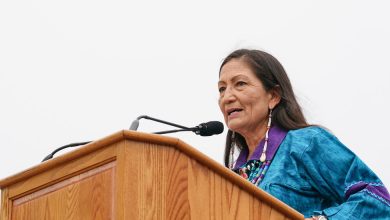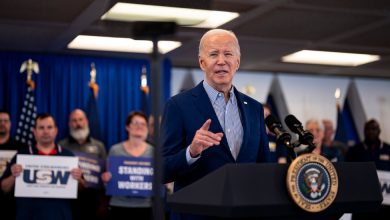Mortgage Bills Are Coming Again. $10 Billion in Aid May Arrive First.

Hundreds of members of the Ho-Chunk Nation were put out of work when the pandemic forced casinos and other businesses to close, only worsening the plight of a 7,800-member tribe whose unemployment rate was over 30 percent even before the coronavirus arrived.
Now, with winter coming to Wisconsin and many of its members worried about heating — and, in some cases, keeping — their homes, a federal program aimed at the country’s most vulnerable homeowners is providing a lifeline.
“Forty percent of Ho-Chunk are homeowners,” said Neil Whitegull, executive director of the tribe’s Housing and Community Development Agency. “And we have a lot of intergenerational families.”
The tribe is an early beneficiary of the $10 billion federal Homeowner Assistance Fund, part of the $1.9 trillion relief plan enacted by Congress and the Biden administration. The legislation gives state, territorial and tribal governments wide latitude to help homeowners with expenses, with priority given to those who live in an area of “persistent poverty” or belong to a group that has been the subject of historical racial, ethnic or cultural discrimination.
About $1 billion has already been distributed, fully funding smaller efforts like those of the Ho-Chunk Nation and financing pilot projects along with states’ costs for establishing programs. This week, New York became the first state to receive final approval for its plan; Gov. Kathy Hochul said in a statement that New York would distribute nearly $539 million for homeowners who were “at the greatest risk of foreclosure or displacement.”
The Homeowner Assistance Fund will be crucial for still-struggling homeowners now that other measures — particularly the forbearance programs that put mortgage payments on hold for millions of Americans — are coming to an end.
“Time is of the essence because the foreclosures will be starting next year,” said Alys Cohen, a staff attorney with the National Consumer Law Center.
Cassandra Moreno, who only recently returned to work as an accountant at the Ho-Chunk casino in Madison, Wis., said she and her husband will apply for help with their $1,500 monthly mortgage payment when the tribe’s program opens this week.
Ms. Moreno, 26, said her husband, a gymnastics instructor, wasn’t working yet, making it a challenge to meet the bills associated with a three-bedroom home and three children, even with unemployment benefits, relief checks from the tribe and child tax credit payments.
“It all comes out of savings, and that is kind of dwindling,” she said.
Each program sets its own rules, including how long it provides aid, the amount per household and the expenses covered. New York, for example, will provide up to $50,000 for costs including mortgage payments, utilities, broadband service and delinquent property taxes, with payments going directly to loan servicers, utility providers or tax authorities.
The Ho-Chunk Nation plans to use much of the $3 million it received on heating costs, Mr. Whitegull said. “The majority of these funds are to be used for utility payments, natural gas, propane and wood,” he said. “The primary sources of heating.”
That flexibility is important because of the success the federal government has had helping homeowners avoid foreclosure. In September, 3,900 new foreclosures were started by banks in the United States, the third-lowest monthly total ever, according to Black Knight, a real estate and mortgage data analysis firm. And the number of borrowers relying on mortgage payment deferrals is at its lowest level since the pandemic began.
“There has been significant stress, but we have done a good job of minimizing it,” said Andy Walden, an economist and vice president of market research for Black Knight.
The Homeowner Assistance Fund was modeled on the $9.6 billion Hardest Hit Fund. That fund was established as a result of the 2008 housing crisis, when more than seven million people lost their homes in a collapse caused by a plethora of subprime loans and adjustable-rate mortgages. A recent academic study found that the program, which assisted 418,156 homeowners in 18 states, reduced participants’ chances of default or foreclosure by 40 percent.
For the Homeowner Assistance Fund, Treasury officials will allow states to permit applicants to pay for renovations to make their homes more livable for extended families. They also expanded the definition of homeownership to include residences bought with a nontraditional home loan, such as the so-called chattel loans often used for mobile homes, and financing arrangements called contract for deed, an installment loan provided by the seller of a home. A review by the Pew Charitable Trusts found that more than a dozen states have submitted plans to cover such homeowners, who often can’t get traditional mortgages.
Angela Ware, who lost her job with an aviation maintenance company a few months into the pandemic, is part of Ohio’s Save the Dream program, one of more than a dozen pilot projects underway across the country. She has paused payments on her three-bedroom house in Cincinnati, but the $880 bill will start arriving again in January, and she’s waiting for her loan servicer to accept six months of payments through the program.
“Oh, my God, it has been very hard,” Ms. Ware said. “I am living off my credit.”
Ms. Ware, who said she had refused to be vaccinated against Covid-19 for religious reasons, said the program would cover her mortgage while she sought a job that would grant her a religious exemption — which has been a struggle so far.
Treasury officials said communication would be crucial to avoiding the delays that snarled $45 billion in emergency rental assistance that was also included in the relief legislation.
“One of the most important things is the outreach by the states to borrowers, and that could mean working with not-for-profits and housing counselors to make sure that borrowers know what is available,” said Will Corbett, senior adviser to Treasury on emergency housing programs.
The 580-homeowner pilot program in Ohio has already provided lessons. Some legal services lawyers said they were concerned that the online application was in English only.
Mikaela Hunt, a spokeswoman for the Ohio Department of Commerce, said the state had begun translating Save the Dream fact sheets into Arabic, Chinese, French, Somali and Spanish.




